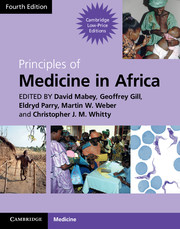Book contents
- Frontmatter
- Contents
- Contributors
- Foreword
- Section 1 Health and disease
- Section 2 Mother and child health
- Section 3 Infection: general principles
- Section 4 Major common infections
- Section 5 Bacterial infections
- Section 6 Viral Infections
- Section 7 Protozoal infections
- Section 8 Helminth infections
- 46 Intestinal helminths
- 47 Schistosomiasis
- 48 Lymphatic filariasis and loa loa
- 49 Onchocerciasis
- 50 Cysticercosis
- 51 Hydatid disease
- 52 Paragonimiasis
- 53 Trichinellosis
- 54 Guinea worm
- Section 9 Fungal infections
- Section 10 Non-communicable diseases
- Section 11 Diseases of body systems
- Section 12 Cancer and Palliative Care
- Section 13 Venoms and Poisons
- Index
- References
46 - Intestinal helminths
from Section 8 - Helminth infections
Published online by Cambridge University Press: 05 March 2013
- Frontmatter
- Contents
- Contributors
- Foreword
- Section 1 Health and disease
- Section 2 Mother and child health
- Section 3 Infection: general principles
- Section 4 Major common infections
- Section 5 Bacterial infections
- Section 6 Viral Infections
- Section 7 Protozoal infections
- Section 8 Helminth infections
- 46 Intestinal helminths
- 47 Schistosomiasis
- 48 Lymphatic filariasis and loa loa
- 49 Onchocerciasis
- 50 Cysticercosis
- 51 Hydatid disease
- 52 Paragonimiasis
- 53 Trichinellosis
- 54 Guinea worm
- Section 9 Fungal infections
- Section 10 Non-communicable diseases
- Section 11 Diseases of body systems
- Section 12 Cancer and Palliative Care
- Section 13 Venoms and Poisons
- Index
- References
Summary
Parasitic worms may be the commonest agents of chronic infection in humans
There are approximately 25 major helminth infections of humans that all, to some extent, have public health significance (Warren et al., 1993), but amongst the most common of all human infections are the intestinal nematodes. Recent global estimates indicate that more than one-quarter of the world's population is infected with one or more of the most common of these parasites: the roundworm, Ascaris lumbricoides; the hookworms, Necator americanus and Ancylostoma duodenale; and the whipworm, Trichuris trichiura. The burden of other intestinal nematodes, including Strongyloides stercoralis and Enterobius vermicularis, are ill-defined due to practical difficulties in diagnosing sub-clinical infections. Cestodes are also of major public health and economic importance. In Africa, helminth infection is most prevalent among rural communities (but also occurs in urban areas) in warm and humid equatorial regions and where sanitation facilities are inadequate. Even within areas of low prevalence, small localized areas of high prevalence can exist.
The distribution of helminths amongst hosts is over-dispersed: whilst the majority of hosts harbour few or no worms, a few harbour much larger numbers of parasites. This fact has clinical consequences for the host, as it is the intensity of infection that is the central determinant of the severity of morbidity. Maximum intensity of hookworm infections is usually not attained until 20–25 years. In contrast, as shown in Fig. 46.1, the age–intensity profile for Trichuris trichiura and Ascaris lumbricoides is typically convex with maximum intensity at 5–10 years of age. After peak intensity has been attained, there is a dramatic decline in intensity to a low level, which then persists throughout adulthood.
- Type
- Chapter
- Information
- Principles of Medicine in Africa , pp. 434 - 440Publisher: Cambridge University PressPrint publication year: 2013

